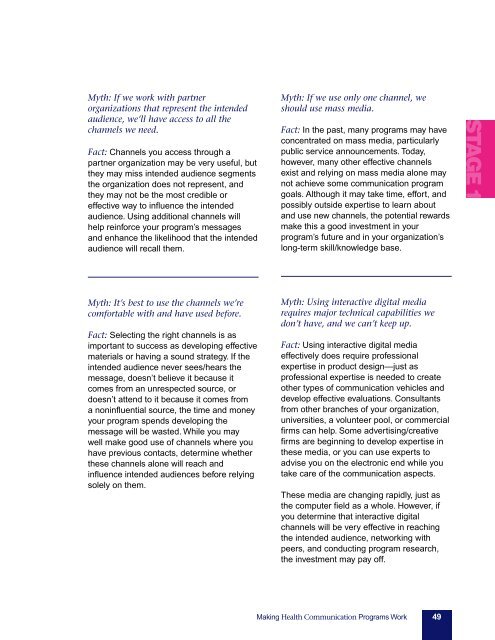pink-book
pink-book
pink-book
Create successful ePaper yourself
Turn your PDF publications into a flip-book with our unique Google optimized e-Paper software.
Myth: If we work with partner<br />
organizations that represent the intended<br />
audience, we’ll have access to all the<br />
channels we need.<br />
Fact: Channels you access through a<br />
partner organization may be very useful, but<br />
they may miss intended audience segments<br />
the organization does not represent, and<br />
they may not be the most credible or<br />
effective way to influence the intended<br />
audience. Using additional channels will<br />
help reinforce your program’s messages<br />
and enhance the likelihood that the intended<br />
audience will recall them.<br />
Myth: If we use only one channel, we<br />
should use mass media.<br />
Fact: In the past, many programs may have<br />
concentrated on mass media, particularly<br />
public service announcements. Today,<br />
however, many other effective channels<br />
exist and relying on mass media alone may<br />
not achieve some communication program<br />
goals. Although it may take time, effort, and<br />
possibly outside expertise to learn about<br />
and use new channels, the potential rewards<br />
make this a good investment in your<br />
program’s future and in your organization’s<br />
long-term skill/knowledge base.<br />
STAGE 1<br />
Myth: It’s best to use the channels we’re<br />
comfortable with and have used before.<br />
Fact: Selecting the right channels is as<br />
important to success as developing effective<br />
materials or having a sound strategy. If the<br />
intended audience never sees/hears the<br />
message, doesn’t believe it because it<br />
comes from an unrespected source, or<br />
doesn’t attend to it because it comes from<br />
a noninfluential source, the time and money<br />
your program spends developing the<br />
message will be wasted. While you may<br />
well make good use of channels where you<br />
have previous contacts, determine whether<br />
these channels alone will reach and<br />
influence intended audiences before relying<br />
solely on them.<br />
Myth: Using interactive digital media<br />
requires major technical capabilities we<br />
don’t have, and we can’t keep up.<br />
Fact: Using interactive digital media<br />
effectively does require professional<br />
expertise in product design—just as<br />
professional expertise is needed to create<br />
other types of communication vehicles and<br />
develop effective evaluations. Consultants<br />
from other branches of your organization,<br />
universities, a volunteer pool, or commercial<br />
firms can help. Some advertising/creative<br />
firms are beginning to develop expertise in<br />
these media, or you can use experts to<br />
advise you on the electronic end while you<br />
take care of the communication aspects.<br />
These media are changing rapidly, just as<br />
the computer field as a whole. However, if<br />
you determine that interactive digital<br />
channels will be very effective in reaching<br />
the intended audience, networking with<br />
peers, and conducting program research,<br />
the investment may pay off.<br />
Making Health Communication Programs Work 49


